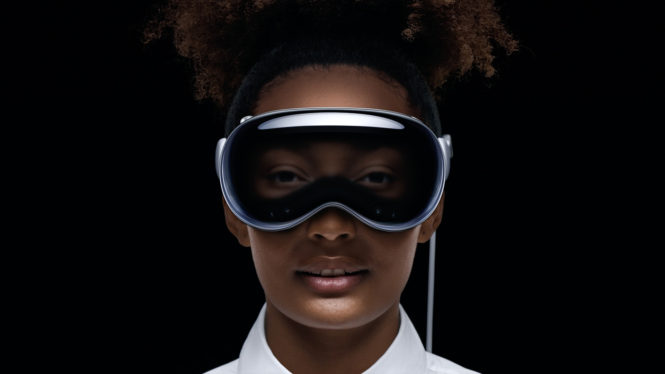After a reported seven years of development, Apple’s AR headset is finally here. It’s been a minute since we’ve had a “one more thing” moment. The wisdom, efficacy and ultimate fate of the product have yet to be determined, but one thing we can finally say for certain: unlike the long-rumored Apple television and car, it’s real and it’s finally here.
“With Vision Pro, you’re no longer limited by a display,” Tim Cook said, introducing the new headset. Unlike earlier mixed reality reports, the system is far more focused on augmented reality than virtual. The company refresh to this new paradigm as “spatial computing.”

It’s a way of interacting with the computing UI – something the company is referring to as kind of input device, akin to a mouse or trackpad. The headset is surprisingly similar to earlier renders – it does, indeed, look ski googles. Clearly this thing isn’t meant to be worn outside the home or office.
The headset is based on an aluminum frame, with curved glass up front. There’s a physical button for image capture and a digital crown for adjustments. The rear is a flexible strap, and visor extends from the display to the wearer’s head, to keep light out. On the sides are built-in “audio pods,” providing the sound.This is finally spatial audio’s time to shine — it’s now clear why Apple has been pushing it in such a big way. The system is designed to create the illusion of different audio sources.
The headset runs on the standard M2 chip, pair with a new R1 chip, which takes on the video streaming. The displays are micro-OLED, with an impressive 64 pixels in roughly the space of a standard iPhone pixel. The three-element lens is designed to improve the imaging from all angles. The company also teamed up with Zeiss to bring custom prescription glass inserts, rather than accommodating for the wearer’s glasses.

The hardware utilizes a new feature called “EyeSight,” which uses a front facing display to reveal your eyes to other people in the room (compensating for the opaque visor), creating a “authentic representation of you” on the curved front glass. This is accomplished through an initial facial scan. That image is also used as your avatar to represent you to other people wearing the headset.
While the product is, indeed, mixed reality (owing to the need for on-board passthrough), the company seems disinterested in engaging with the virtual reality conversation.
Interestingly, it does appear to be a work first device. It’s telling that the company is focused on things like email, rather than, say, gaming. In fact, users can actually bring a version of their Mac desktop over, projected out in front of them. Apple really went to great lengths to avoid a touchscreen Mac, it seems.
The opaque display lets the room darken around images. In fact, the company is really pushing 2D photos taken from the iPhone here. There’s a 3D camera built in, as well, allowing users to capture “Spatial” photos and videos. There’s a movie theater option as well, taking advantage of illusion of a full, large screen.There is gaming here, but rather than an actual VR experience, it’s a large screen projection, with standard games.

Disney (who else?) is the first content partner here, which does bode well for future experience. Bob Iger took to the stage today to announce that Disney+ will be available at launch on the device. The entertainment mogul understandably had a lot of faith in Apple here.
In spite of earlier rumors around an adapted iPadOS, the company introduced VisionOS, a new operating system “designed from the ground up” for spatial computing. Much like the iPad’s initial launch, there are a number of educational features, including astronomical and health apps, as well as one for music creation.
Apple says the system will work with Microsoft Office apps, as well as teleconferencing services like WebEX and Zoom. VisionOS runs on the same framework as iOS and iPad OS, meaning that existing apps will port over. The company is also launching a new App Store specifically for the headset. It’s teamed with Unity, as well, to support development tools for games, which should offer a better experience than simply porting over existing games.
A new version of FaceID called OpticId brings security features for using things like Apple Pay. Meanwhile, camera data is processed on-board and the company doesn’t log where you look.

What’s clear is this is all extremely early stages. For one thing, the product was announced today, in order to bring more developers on board. For another, the experience as depicted in the presentation are all renders. Of course, that also owes to the difficulty of presenting a 3D experience on a 2D video – this is something the company will keep running into with the product.
It will be available early next year. Better start saving up now, because this thing is going to run $3,499. Yep. It’s clearly focused on enterprise buyers, rather than regular consumers. Keep in mind, however, the “Pro” part of the name seems to suggest that a more affordable (relatively speaking) version will be coming at some point in the future.
Apple’s $3,499 Vision Pro AR headset is finally here by Brian Heater originally published on TechCrunch



